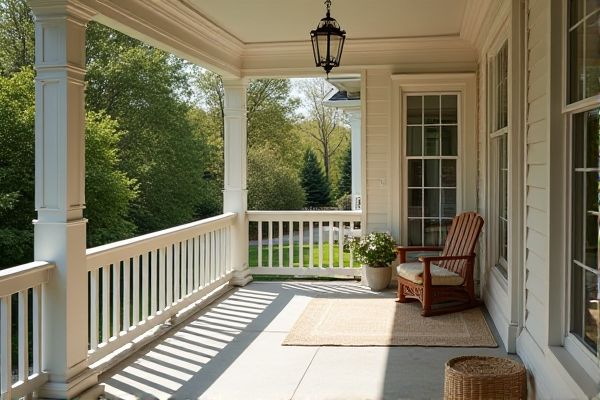
Choosing between a porch with railing and one without impacts both safety and aesthetic appeal, as railings provide essential support and define the space while open porches offer an unobstructed view and a more spacious feel. Explore the rest of the article to understand how Your choice affects functionality, style, and value.
Table of Comparison
| Feature | Railing (Porch) | No Railing (Porch) |
|---|---|---|
| Safety | Provides fall protection, especially for elevated porches | Increased risk of falls, less safe for children and elderly |
| Building Code Compliance | Often required by local building codes for porches over 30 inches | May violate building codes if porch height exceeds limits |
| Privacy | Offers moderate visual barrier depending on design | No privacy barrier, fully open space |
| Aesthetic Appeal | Enhances architectural style and curb appeal | Minimalist look, less architectural detail |
| Maintenance | Requires regular upkeep (painting, repairs) | Lower maintenance with no railing components |
| Cost | Additional material and installation cost | Lower initial cost, no extra installation needed |
Introduction: The Importance of Porch Safety
Porch safety significantly reduces fall risks, with railings providing crucial support and stability for users. Building codes often mandate railings for elevated porches to enhance security and prevent accidents. Choosing railings improves accessibility and compliance, ensuring a safer outdoor space for all age groups.
Visual Appeal: Railing vs. Open Porch Design
Railing on porches enhances visual appeal by adding structure and a defined boundary, often complementing architectural styles with decorative elements like spindles or ironwork. An open porch design offers a minimalist and spacious look, promoting unobstructed views and seamless interaction with the outdoor environment. Choosing between railing and no railing influences curb appeal and ambiance, balancing aesthetics with safety considerations.
Safety Considerations: Protecting Family and Guests
Railing on a porch significantly enhances safety by preventing falls, especially for children, elderly family members, and guests. Building codes often require railing to meet specific height and strength standards to ensure reliable protection. Without railings, the risk of accidents increases, making it essential to install sturdy, code-compliant barriers for optimal family and guest safety.
Building Codes and Legal Requirements
Building codes typically mandate porch railings when the height from the porch floor to the ground exceeds 30 inches to prevent fall hazards, with specifications on railing height, spacing, and structural integrity. Absence of required railings can lead to code violations, fines, or property insurance complications, emphasizing the importance of adhering to local regulations. Compliance with International Residential Code (IRC) standards often serves as the baseline for railing requirements in residential porch construction.
Cost Analysis: Installing Railing vs. No Railing
Installing a porch railing typically increases project costs by 20-40%, due to materials like wood, metal, or composite and labor for secure installation. Opting for no railing reduces expenses significantly but may require compliance with local building codes that mandate safety measures for elevated porches. Evaluating long-term maintenance costs and potential resale value is essential when deciding between railing installation and leaving the porch open.
Maintenance Needs: Upkeep With and Without Railings
Railings on your porch require regular cleaning, painting, or staining to prevent rust, rot, or fading, increasing ongoing maintenance efforts. Without railings, maintenance focuses mainly on the flooring and structural integrity, reducing the areas needing frequent upkeep. Choosing between railing and no railing impacts the time and resources spent on maintaining your porch's appearance and safety.
Accessibility: Ease of Use for All Ages
Porch railings enhance accessibility by providing stable support for seniors and individuals with mobility challenges, reducing the risk of falls. Without railings, users may struggle to maintain balance, especially on elevated or narrow porches. Incorporating sturdy railings ensures safer and easier navigation for people of all ages and physical abilities.
Space Utilization: Open Feel vs. Defined Boundaries
Choosing a porch railing impacts space utilization by creating defined boundaries that enhance safety and structure, ideal for delineating your outdoor area. Opting for no railing fosters an open feel, promoting a seamless transition between the porch and surrounding yard, which maximizes visual space and encourages freer movement. Your decision influences both the functional use and aesthetic appeal of the porch environment.
Resale Value: Impact on Property Marketability
Porches with railings generally boost resale value by enhancing curb appeal and providing added safety, making the property more attractive to buyers. Homes without railings may deter families or elderly buyers who prioritize safety features, potentially limiting marketability. Real estate data indicates properties with well-maintained porch railings sell faster and often at higher prices than those lacking this feature.
Final Verdict: Choosing the Best Option for Your Home
Railing on porches enhances safety by preventing falls and fulfilling building codes, making it essential for homes with children or elderly residents. However, no railing offers an unobstructed view and a minimalist aesthetic, ideal for homes prioritizing modern design and open space. Homeowners must balance safety requirements with style preferences to select the best porch option tailored to their specific needs.
 homyna.com
homyna.com